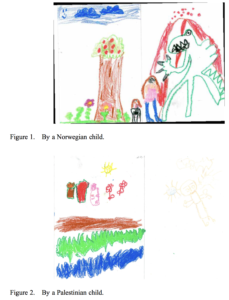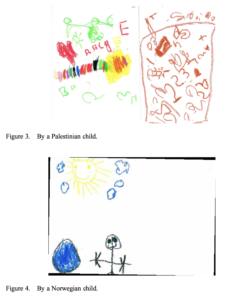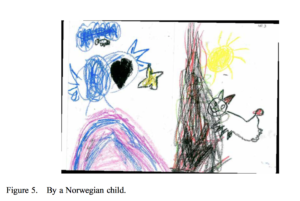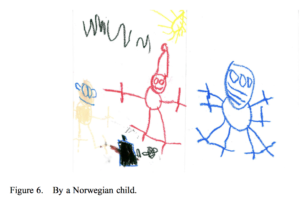(Online)
Drawing project between children in Norway and in Palestinian refugee camps in Lebanon.
period 2002-2009
The idea behind the two projects was to give the children an arena where they could express how they experienced joy and fear, while also giving them an opportunity to see how children from a completely different culture experienced the same emotions.
Author: Tone Sunde The projects started in the early 2000s, and were the result of an established collaboration between the University of South East Norway (Tone Sunde and Eva Magerød) and the American University of Beirut and the NGO Beit Atfal Assoumond (Najla Bajour).The project “Children’s expression” was carried out in 2002 and “What makes me happy, and what makes me scared?” 2009.
The participants in the projects were two kindergartens in Palestinian refugee camps in Lebanon and three kindergartens in southeast Norway. The children had to express themselves by drawing and then put what they had drawn into words. The children were given a large sheet of paper that was divided in two, where they had to draw something that scared them on one side and something that made them happy on the other. They then told an adult, who wrote down what they had drawn on each of the pages. The descriptions were then translated into Arabic and Norwegian respectively.
During the process, the children were enthusiastic as they drew. They were detailed and conscious of what they were communicating when they told us what they had drawn. They explained in detail and corrected if they felt that the text did not match what they wanted to convey. It was clear that they felt it was important to convey exactly what they had intended with their drawing.
The children were asked to share their thoughts and feelings with children from another culture and this was done through two public exhibitions in Beirut and in two cities in Southeast Norway. The drawings of all the children were hung up with the text in Arabic and Norwegian. This made it possible for the children to see and be read to, what the children from all the other children participating in the project had wanted to convey.
It was interesting to see how interested they were in their own drawings. It was also clear that the children wanted to see the drawings of the other children – both the Palestinian and the Norwegian children.
In the children’s drawings, there were many similarities between the Palestinian and Norwegian children, especially when it came to what made them happy. The differences emerged in the drawings in that the Palestinian children had concrete things such as the sun, family members and friends that made them happy, while most of the Norwegian children referred to activities such as trips and the like that they did with family and friends. When it came to what made the children afraid, there were differences in that the children from the Palestinian refugee camps were afraid of “real” things from the local environment, such as wild cats and dogs and unfamiliar things like the sea. Children in Norwegian kindergartens were afraid of imaginary things like ghosts, monsters and fire-breathing dragons and animals that are not in our immediate vicinity, such as lions, tigers and crocodiles.
The projects were presented at two EECERA conferences in 2006 and 2012. At the same time, an article was included in the European Early Childhood Education Research Journal 2016.
—-






Excerpts (project description ppt. presentation:
“What makes me happy, and what makes me scared? An analysis of drawings by Norwegian and Palestinian children”.
Vestfold University College
Tone Sunde, Assistant Professor and Eva Maagerø
Vestfold University College
Samar Mukallid, Ph.D at
American University of Beirut
Dr. Najla Bashour
Beit Atfal el-Somoud, Lebanon.
Background:
Cooperation between American University of Beirut (Najla Bashur), Lebanon and Vestfold University College, Norway
48 drawings (19 from Norway and 29 from Palestinian refugee camps in Lebanon)
The children were between 5 and 6
The drawings were made in kindergartens, organized by preschool teachers
Co-operation since 1999
Pre-projects in KG’s in refugee camps in Lebanon.
Inspiration for this pilot project
Purpose of the pilot project
Analyse to see if there are any differences between the children’s expression in the two cultures.
Give the children the opportunity to express their emotions in different media.
The children will see their own expressions in an exhibition.
Give the teachers experience in taking children’s perspective
Strengthen the children’s identity; their self-esteem and self-confidence.
Method:
Children were selected by preschool teachers
Parents were informed – it was voluntary to participate
Same drawing material was supplied in both countries
Instructions to the children were:
Draw something that makes you happy
Draw something that makes you scared
A brief oral explanation by each child of what they had drawn, was written down by the preschool teachers
Translations between the two languages Norwegian and Arabic were provided
Action learning / action research
The personnel in the KG’s participated in the design of the project
The children were engaged in the process
Focus groups – 4 KG’s and 30 children age 6 in both countries
Documentation of the process and the exhibition
The children’s drawings
The children were asked to respond to the following two questions with a drawing: “What are you afraid of?” “What makes you happy?”
Why drawings?
Drawing provides children with their first means of making a permanent, tangible, concrete, and communicable record of their ideas (Brooks 2009)
The materiality of a drawing offers opportunities for ideas to be shared with others, to be re-visited and to be discussed
Drawing gives children experience with symbolic systems beyond words
A beginning of literacy
Research questions:
Do we find similarities between the drawings by the Norwegian and the Palestinian children?
Do we find some patterns among the Norwegian children’s drawings?
Do we find some patterns among the Palestinian children’s drawings?
Theory: Social semiotics
Visual meaning making
Representation, interaction and composition
Representation
(Kress and van Leeuwen 2006, van Leeuwen 2005)
Research question 1:
Do we find similarities between the drawings made by the Norwegian and the Palestinian children?
Research question 2:
Do we find some patterns among the Norwegian children’s drawings?
Research question 3:
Do we find patterns between the Palestinian children’s drawings?
Summing up
More similarities among the children in the representations of “What makes me happy?”
More differences among the Norwegian and Palestinian children in the representations of “What makes me scared?” – phantasy figures vs. the real surroundings
The context the children live in, seems to be of importance
LITERATURE SOURCE/REFERENCE
Brooks, Margaret (2009): “Drawing to learn”. In: Marilyn Narey (ed.): Making Meaning. Constructing Multimodal Perspectives of Language, Literacy, and Learning through Arts-based Early Childhood Education. New York: Springer
Kress, Gunther and Theo van Leeuwen (2006): Reading Images. The Grammar of Visual Design. London: Routledge
Van Leeuwen, Theo (2005): Introducing Social Semiotics. London: Routledge

